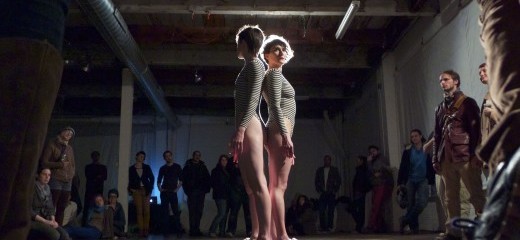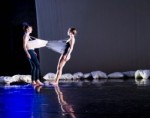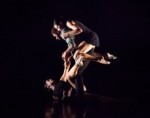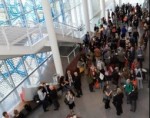
A Colonial Give and Take
By Debbie Shapiro
Can I use repetition and endurance as the driving format of this piece I’m about to write? Can I control myself and hold back from reading what Christina Gesualdi wrote about a performance of this same work in September? Can I get through this by phrasing everything as a question? What if I suddenly shift direction, but with precision? How can something from the beginning of what I’m writing here repeat and become part of the end in another way?OK I give up. I want to respond to Colony with reciprocity and rigor, echoing what I saw demonstrated in the piece. But I also know (it was mentioned in the talk-back after Sunday’s show) that it took long, intense rehearsals and specific conditioning for creator-performers Melissa Krodman and Kelly Bond to develop and then prepare for each performance. And it paid off. Their experimental duet, presented at thefidget space this weekend (its second Philadelphia run in a little less than six months) is about masterful control of the body. For the entire 50-minute performance, two young women in matching black and white striped ’80s leotards and Keds danced in seductive, trippy, and spot-on unison. Think Robert Palmer’s “Simply Irresistable” girls, put through an Olympic training boot camp, and then through Alice’s looking glass.
When I entered the white-shrouded space, the piece had already started, with the dancer twins side-by-side, hop-running in place in a movement resembling trenches from an old black and white tap dance movie. The small spotlight from a single lamp, combined with the buzzing, electronic ambient pulse, captivated me immediately. From their corner in the loft, the performers commanded the entire space. They never stopped. Or at least that’s what I remember thinking in the beginning. Time passed, and we stood around and watched as these two human beings showed no sign of fatigue, or shortness of breath--their faces locked in to a focused, neutral meditation. Left. Right. Left. Right. Entranced, I alternated between fixating on their steps—light, despite all the work they were doing, and the tops of their hips—a body part accentuated by this particular cut of leo. As they continued, and the pulsing sound increased in intensity, I stood still in the shadow, awed by this feat of endurance. The extreme repetition had transported me outside the space altogether. I felt stressed with adrenaline, rooting for these two racers, and then returned back to the real context of the piece unfolding before me.
A big shift of movement and sound popped the accumulated dramatic pressure, and I welcomed it, delighted to notice the dancers had been counting in sync for that entire section. Or were they? How else would they have stayed so together? They allowed themselves a few long breaths, then shifted into traveling with weightless, careful steps. They moved through and around us, at times mapping the space between them in such a way that one was the mirror reflection of the other (if that mirror cut diagonally across the room). If, along their journeys, either caught an audience member with their insistent gaze, the response was likely a smile, giggle, or visible attempt to out-gaze in return. I thought about our freedom of choice to reciprocate, as audience members, and as people. I felt myself just as present as the performers, and just as willing to perform back had they looked my way. Why did I feel so generous in that room?
A few lines of text wove through the journey of the piece. Early on, without warning, “just you and nobody else but you,” sung in unison, of course, layered a showgirl element on what had previously felt robotic. “We are singular sensations” repeated from their blood red lips as they cross-stepped around the perimeter. I realized now how specifically worked-out this dance was. Perhaps even the length and depth of breaths between “sensations” were measured. I felt taken care of: I never yearned for meaning or interpretation and, instead, basked in the artfulness of Colony’s construction and execution.
Just as I released my active attention (during a moment of stillness), a beat began, like an alarm clock, and took over their eyeballs. Just the eyeballs. I checked the two pairs against each other, and the connectedness prevailed. Almost spooky. Eventually, the invisible force lost its hold over the two showgirl-robots, and they broke unison. Each found someone (an audience member), on opposite sides of the room, and told them sweetly, “I’m in love with you.” But as more someones followed, the repetition of “I’m in love with you” remained consistent in delivery and tone. It wasn’t said to me, and so I followed one dancer around, to catch her eyes, always tracking the other in the distance, until the section dissolved into the beginning of the end. “I’m in love with you…just you and nobody else but you….”
When did this dance really begin? Forty-seven or so minutes into Colony I forgot time, and wondered if these two creatures were always here, in this room, in love with me. And running in place. And mirroring each other. And counting steps. And breaths. And beats. I looked around and most of the audience stepped out, as if it was the right thing to do. There was no signal. No end end. Bond and Krodman were shifting their weight from their right hip to their left now. Right to left. Right to left. One pressed closely against the other, until the last set of audience eyes was gone.
Colony, Kelly Bond and Melissa Krodman. thefidget Space, March 2-3. No further performances.
By Debbie Shapiro
March 12, 2013










